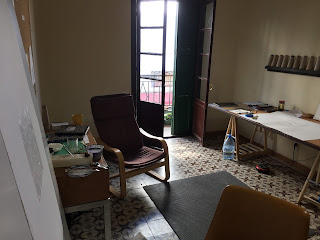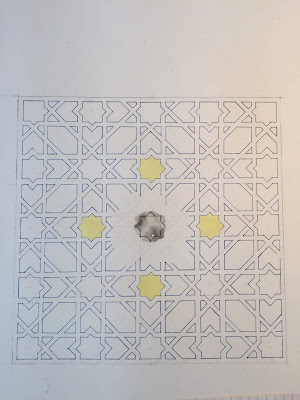In July 2017, I started a University Sabbatical by restructuring
the studio space of my practice and participated in an Artist Residency in
Morocco.
 |
| Entrance to Kasbah, Matisse, 1912 |
 |
| Matisse, Diebenkorn |
-->I flew to the residency, called Green Olive Arts in Tetouan, Morocco from Los Angeles, stopping over in Madrid, Spain. I was picked up at the Tangier airport in Morocco by residency co-founder and co-director, Rachel Pearsey. We had a one-hour taxi ride to the Mediterranean port-city of Tetaouan.

 | ||
| Tetaouan, Morocco |
-->
The Residency/The City
The residency facility consists of four well-lit studios,
each with a balcony that overlooks the market place. There is also a small
library, a full kitchen, a computer station, small fabrication shop, art supplies,
and administration offices. The residency intentionally boards each of the
visiting artists in the community within easy walking distance of the studio
complex. This immerses the visiting artist into the daily pulse of the city,
walking back and forth each day with quick stops at the local bakery, produce
stand, or a cup of Arabic coffee.
 |
| Studios |

 |
| street view from studio |
The city is known as the art center of Morocco, home to the Institute
Nalional des Beaux-Arts and the Royal Artisan School of Tetouan. The city hosts
a variety of art events and cultural festivals every year, including 2-3 film
festivals, an international lute festival, concerts, cultural weeks, parades,
and Andalusian music events celebrating the richness of North Africa.
 |
| Peter, Rachel, and Jeff |
--> The residency hosts 4 to 6 visual artists and writers from the international community. Each artist determines their own length of residency ranging from 2 weeks to 2 months with the average stay being 3 weeks. During my 2-week stay there were 2 other visual artists in-residence: New Zealand artist/designer, Johann Nortje and Moroccan artist, Hajar Daide.
My Work
--> On my first full studio day I met with a master pattern maker to study and practice Islamic pattern design. We did several traditional patterns using only a simple compass, no rulers or straight edges. As we worked I began to see the foundations of abundant richly designed patterns that embellished the city from the ornate tile work to the decorative wrought iron patterns to the textiles and elaborately woven rugs.

By the end of that first day, I had determined the work I would do during my residency. I decided
to do a series of daily works, one per day, each consisting of a single large
pattern design, with a central form out of which the design would radiate. At
the end of each day, I would partially eradicate the pattern by applying a
series of thin washes of white gesso, leaving the central form a ghost image of
the pattern. This was a daily discipline of concentrated work (based on
Moroccan design forms) that culminated at the end of the day with a remnant of
the process. I deeply contemplated the relationship of presence and memory and
particularly, presence and memory while traveling in a non-native land.
Day Trip to Chefchaouen, the Blue
Village of Morocco
Chefchaouen is a stunning mountain village about an hour from Tetouan. I took a local taxi (along with 4 other occupants) from the Tetouan train station to the gates of Chefchaouen.
The city was founded in 1471 as a small kasbah or fortress to fight the Portuguese invasions of northern Morocco. Along with the Ghomara tribes of the region, many Moriscos and Jews settled here after the Spanish Reconquista in medieval times.
--> Often referred to as “the blue city” or “the blue pearl”, the Chefchaouen is painted or should one say, washed in a sky, rich blue. The buildings, the sidewalks, and even at times the road- ways have been painted, and then painted again often with a blue that is just slightly off tone ,as if the blues were breathing or pulsing.
--> History tells us that during the Spanish Inquisition thousands of Jews fled Europe, so as not to be forced into Christianity. They ended up settling in Chefchaouen, painting all the walls blue, the color of divinity in Judaism. Locals claim that the blue color repels mosquitoes. Walking the streets of “the blue city”was the closest thing I could imagine to walking thru a painting.












































